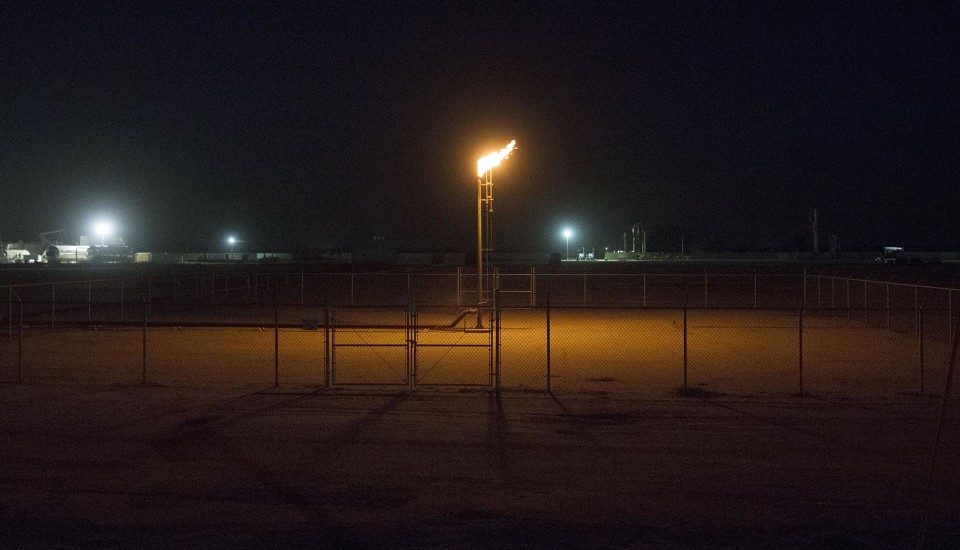5 Things You Didn’t Know About Fracking in California
10.20.2014 • Sarah Craig
climate change • fracking • people • policy • pollution
The fracking boom is making its presence known throughout the nation, transforming communities in unpredicted – and sometimes unwelcome ways. The list of impacts include incidents of contaminated drinking water, stronger and riskier earthquakes, increased air pollution, and skyrocketing housing prices.
When most people think of fracking, North Dakota or Texas comes to mind. These and many other states are experiencing such a boom in oil and gas production, that you can see the activity from outer-space. Night-time satellite imagery reveals round-the-clock operations, as dots of flares burn brightly like stars.
But what most Californians do not know is that those stars are starting to appear within state lines. Fracking is happening next to schools, farms, and homes. Today marks the launch of a journalism project called Faces of Fracking that seeks to highlight those on the front lines; who bear witness to its impacts in our state.
To learn more, start with these 5 things that you may not know about fracking in California.
1. Where is fracking in California?
Most fracking activity in the state is located in the Central Valley, the heart of the state’s (and nation’s) food supply. It is also located in the highly dense metropolis of Los Angeles, where its dangers are magnified. There are even some cases as far north as Glenn County and as far south as Orange County. If it expands, it would most likely be above the Monterey shale and the Miocene Sedimentary Basin.
2. What is fracking?
By now, most people are familiar with the term hydraulic fracking–the process of shooting a mixture of water, sand, and acid into the ground at extremely high pressure to break up rock and release oil from deep underground. But most are not familiar with acidizing, another similar technique that is just as risky, and is the process of using acid to dissolve rock, instead of breaking it apart.
3. Where does all of this water, sand, and chemicals go once it’s used?
The waste from fracking finds its home in injection wells or evaporation ponds. Injection wells hold fracking waste in cement casings and are supposedly built to keep this waste from leaking, forever. But injection wells are known to cause earthquakes, and earthquakes are known to break up cement. And California is an earthquake-prone state. Can you guess what might happen here?
4. What are the biggest impacts?
Narrowing down is tough but here are several impacts worth noting: Number one: It affects our water supply. Fracking uses a lot of water and increases the risk of contaminating our water (and in many cases, doing just that). This in turn affects our health if the chemicals (many of them cancer-causing) get into our water – and our food. Number two: It affects our air with the incineration of excess gases and toxic chemicals. This in turn creates a host of health issues, including breathing and heart problems, aggravation of asthma and other respiratory illnesses, and lung cancer. Number three: Emissions from fracking activities affect our climate, increasing the amount of greenhouse gases in our atmosphere (i.e. global warming) and placing California further away from it’s ambitious goals to fight climate change.
Oh, and one more thing. It makes your ice cream more expensive. (And in some states the traffic is so bad from fracking activity, that if you buy ice cream from the store, it will melt before you can get it home.)
5. Is there a law to make sure that it’s safe?
In January of 2014, Senate Bill 4 was passed in California that requires DOGGR (the Department of Oil & Gas and Geothermal Resources) to collect basic information about fracking, including where and when it is happening, what chemicals are being used, and how much water is being used. A recent article highlights several shortcomings in SB4, revealing that regulators do not have enough capacity to enforce the law and oil companies have inaccurately reported key information.
Furthermore, California’s Governor Jerry Brown, a leader known to take a bold stance on climate, has avoided taking action against fracking, dismissing calls to ban the practice and focus on developing clean energy sources.
Tell others about this
Faces of Fracking is a multimedia project telling the stories of people on the front lines of fracking in California.
